belt CITROEN DS3 CABRIO DAG 2015 Handbook (in English)
[x] Cancel search | Manufacturer: CITROEN, Model Year: 2015, Model line: DS3 CABRIO DAG, Model: CITROEN DS3 CABRIO DAG 2015Pages: 404, PDF Size: 13.93 MB
Page 165 of 404
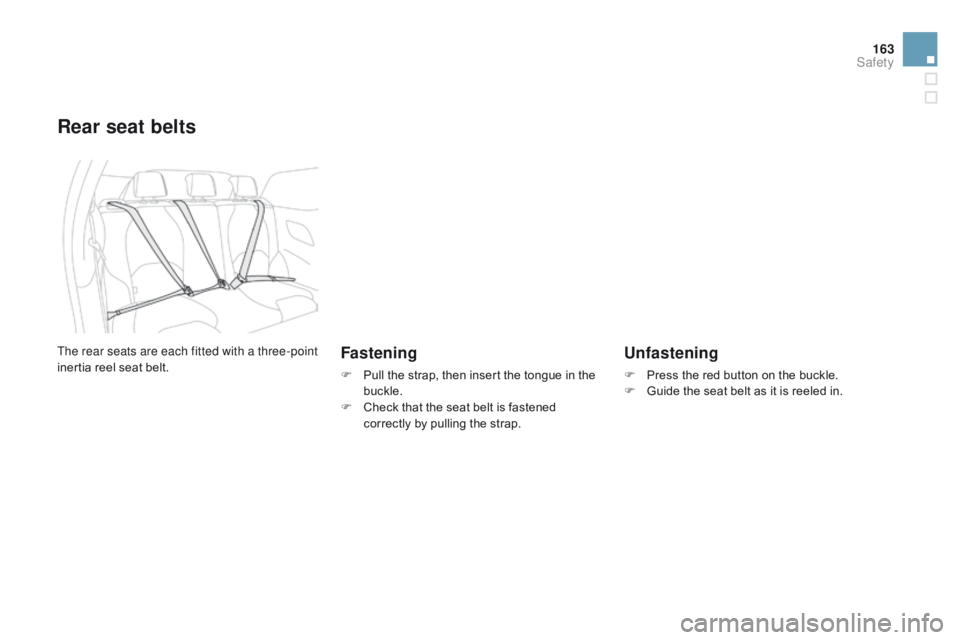
163
DS3_en_Chap08_securite_ed01-2014
Rear seat belts
Fastening
F Pull the strap, then insert the tongue in the buc
kle.
F
C
heck that the seat belt is fastened
c
orrectly by pulling the strap.
Unfastening
F Press the red button on the buckle.
F G uide the seat belt as it is reeled in.
The rear seats are each fitted with a three-point
inertia
reel
seat
belt.
Safety
Page 166 of 404
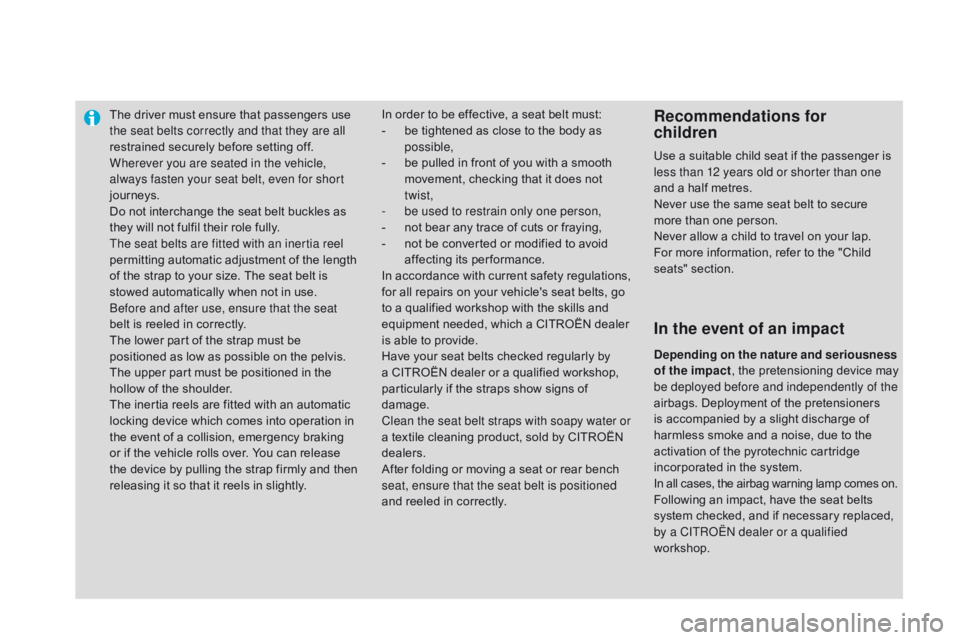
The driver must ensure that passengers use the seat belts correctly and that they are all
restrained
securely before setting off.
Wherever you are seated in the vehicle,
always fasten your seat belt, even for short
journeys.
Do
not interchange the seat belt buckles as
t
hey will not fulfil their role fully.
The seat belts are fitted with an inertia reel
permitting
automatic adjustment of the length
o
f the strap to your size. The seat belt is
s
towed automatically when not in use.
be
fore and after use, ensure that the seat
belt
is reeled in correctly.
The
lower part of the strap must be
p
ositioned as low as possible on the pelvis.
The
upper part must be positioned in the
h
ollow of the shoulder.
The
inertia reels are fitted with an automatic
l
ocking device which comes into operation in
t
he event of a collision, emergency braking
o
r if the vehicle rolls over. You can release
t
he device by pulling the strap firmly and then
r
eleasing it so that it reels in slightly.In
order to be effective, a seat belt must:
- b e tightened as close to the body as
p
ossible,
-
b
e pulled in front of you with a smooth
m
ovement, checking that it does not
t
wist,
-
b
e used to restrain only one person,
-
n
ot bear any trace of cuts or fraying,
-
n
ot be converted or modified to avoid
a
ffecting
it
s
p
erformance.
In
a
ccordance
w
ith
c
urrent
s
afety
r
egulations,
f
or all repairs on your vehicle's seat belts, go
t
o a qualified workshop with the skills and
e
quipment needed, which a CITROËN dealer
i
s able to provide.
Have
your seat belts checked regularly by
a
CITROËN dealer or a qualified workshop,
p
articularly if the straps show signs of
d
amage.
Clean the seat belt straps with soapy water or
a
textile cleaning product, sold by CITROËN
d
ealers.
After
folding or moving a seat or rear bench
s
eat, ensure that the seat belt is positioned
and
reeled in correctly.Recommendations for
children
Use a suitable child seat if the passenger is less than 12 years old or shorter than one
and
a half metres.
Never
use the same seat belt to secure
m
ore than one person.
Never
allow a child to travel on your lap.
For
more information, refer to the "Child
sea
ts"
se
ction.
In the event of an impact
depending on the nature and seriousness
of the impact ,
the pretensioning device may
b
e deployed before and independently of the
airbags.
Deployment of the pretensioners
i
s accompanied by a slight discharge of
h
armless smoke and a noise, due to the
a
ctivation of the pyrotechnic cartridge
i
ncorporated in the system.
In
all cases, the airbag warning lamp comes on.
Following
an impact, have the seat belts
s
ystem checked, and if necessary replaced,
b
y a CITR
oË
N dealer or a qualified
workshop.
Page 167 of 404

165
DS3_en_Chap08_securite_ed01-2014
Airbags
System designed to contribute towards improving the safety of the occupants (with
t
he exception of the rear centre passenger)
i
n the event of violent collisions. The airbags
s
upplement the action of the force-limiting
s
eat belts (with the exception of the centre rear
p
assenger).
If a collision occurs, the electronic detectors
record
and analyse the front and side impacts
s
ustained in the impact detection zones:
-
i
n the case of a serious impact, the airbags
a
re deployed instantly and contribute
towards better protection of the occupants
of
the vehicle (with the exception of the
r
ear centre passenger); immediately after
t
he impact, the airbags deflate rapidly so
t
hat they do not hinder visibility or the exit
o
f the occupants,
-
i
n the case of a minor or rear impact or in
c
ertain roll-over conditions, the airbags
m
ay not be deployed; the seat belt
a
lone contributes towards ensuring your
p
rotection in these situations. This
equipment will only deploy once.
I
f a second impact occurs (during the
s
ame or a subsequent accident), the
a
irbag will not be deployed again.
Impact detection zones
A. Front impact zone.
B. S ide impact zone.
Deployment
of one or more of the
a
irbags is accompanied by a slight
e
mission of smoke and a noise, due
t
o the activation of the pyrotechnic
cartridge
incorporated in the system.
This
smoke is not harmful, but sensitive
i
ndividuals may experience slight
ir
ritation.
The noise of detonation related to the
deployment
of one or more airbags
m
ay result in a slight loss of hearing for
a
short time.
The airbags do not operate when the
ignition is switched off.
Safety
Page 172 of 404
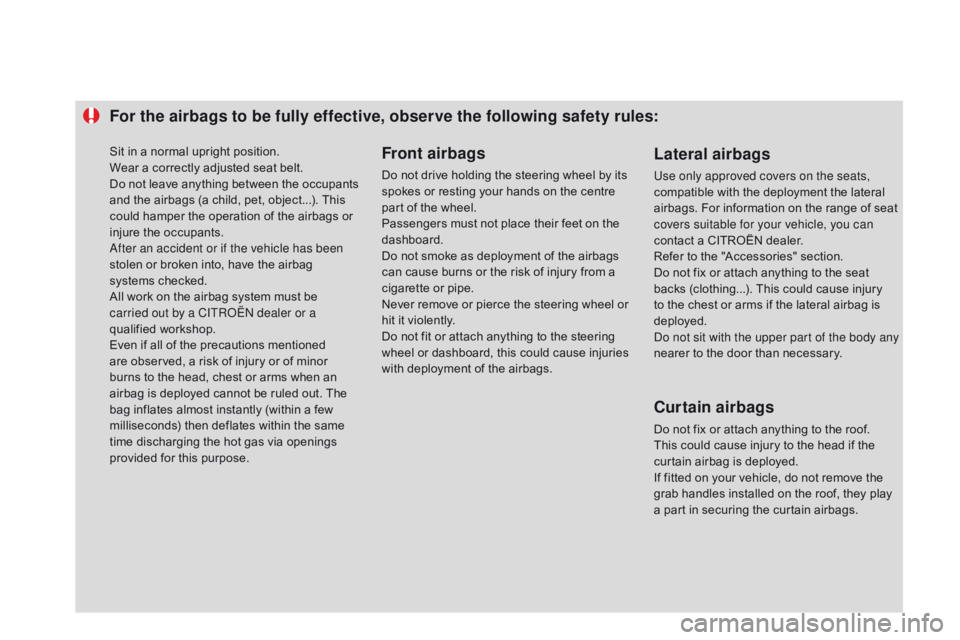
For the airbags to be fully effective, observe the following safety rules:Front airbags
Do not drive holding the steering wheel by its spokes or resting your hands on the centre
p
art of the wheel.
Passengers
must not place their feet on the
das
hboard.
Do
not smoke as deployment of the airbags
c
an cause burns or the risk of injury from a
c
igarette or pipe.
Never
remove or pierce the steering wheel or
h
it it violently.
Do
not fit or attach anything to the steering
w
heel or dashboard, this could cause injuries
w
ith deployment of the airbags.
Lateral airbags
Use only approved covers on the seats,
compatible with the deployment the lateral
a
irbags. For information on the range of seat
c
overs suitable for your vehicle, you can
contact
a CITROËN dealer.
Refer
to the "Accessories" section.
Do
not fix or attach anything to the seat
b
acks (clothing...). This could cause injury
t
o the chest or arms if the lateral airbag is
d
eployed.
Do not sit with the upper part of the body any
nearer
to the door than necessary.
curtain airbags
Do not fix or attach anything to the roof. This could cause injury to the head if the
c
urtain airbag is deployed.
If
fitted on your vehicle, do not remove the
g
rab handles installed on the roof, they play
a
part in securing the curtain airbags.
Sit
in
a
normal
upright
position.
Wear
a
correctly
adjusted
seat
belt.
Do
n
ot
l
eave
a
nything
b
etween
t
he
o
ccupants
a
nd
the
airbags
(a
child,
pet,
object...).
This
c
ould
hamper
the
operation
of
the
airbags
or
i
njure
the
occupants.
af
ter an accident or if the vehicle has been
stolen
or
broken
into,
have
the
airbag
s
ystems
checked.
All
work
on
the
airbag
system
must
be
c
arried out by a CITR
oË
N dealer or a
qualified
w
orkshop.
Even
if
all
of
the
precautions
mentioned
a
re
observed,
a
risk
of
injury
or
of
minor
b
urns
to
the
head,
chest
or
arms
when
an
a
irbag
is
deployed
cannot
be
ruled
out.
The
b
ag
inflates
almost
instantly
(within
a
few
m
illiseconds)
then
deflates
within
the
same
t
ime
discharging
the
hot
gas
via
openings
p
rovided
for
this
purpose.
Page 176 of 404
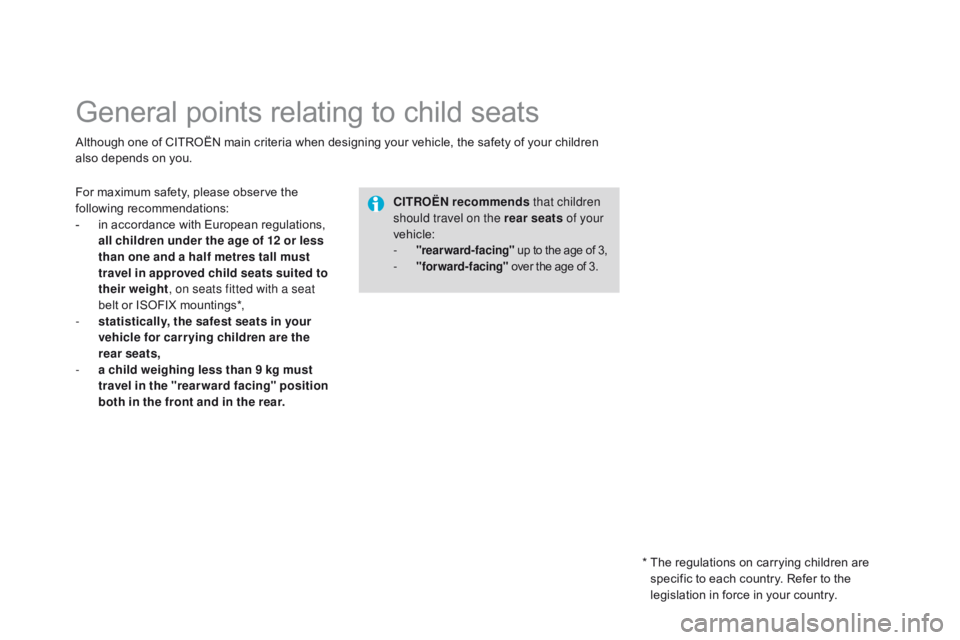
DS3_en_Chap09_securite-enfants_ed01-2014
General points relating to child seats
Although one of CITROËN main criteria when designing your vehicle, the safety of your children also depends on you.
cI
TROËN recommends that children
should travel on the rear seats of your
vehicle:
-
"rearward-facing" up to the age of 3,- "forward-facing" over the age of 3.
For maximum safety, please observe the f
ollowing r ecommendations:
-
i
n accordance with European regulations,
a
ll children under the age of 12 or less
than one and a half metres tall must
travel in approved child seats suited to
their weight , on seats fitted with a seat
belt
or ISOFIX mountings*,
-
s
tatistically, the safest seats in your
vehicle for carr ying children are the
rear seats,
-
a c
hild weighing less than 9 kg must
travel in the "rear ward facing" position
both in the front and in the rear.
*
T
he regulations on carrying children are
s
pecific to each country. Refer to the
l
egislation in force in your country.
Page 177 of 404
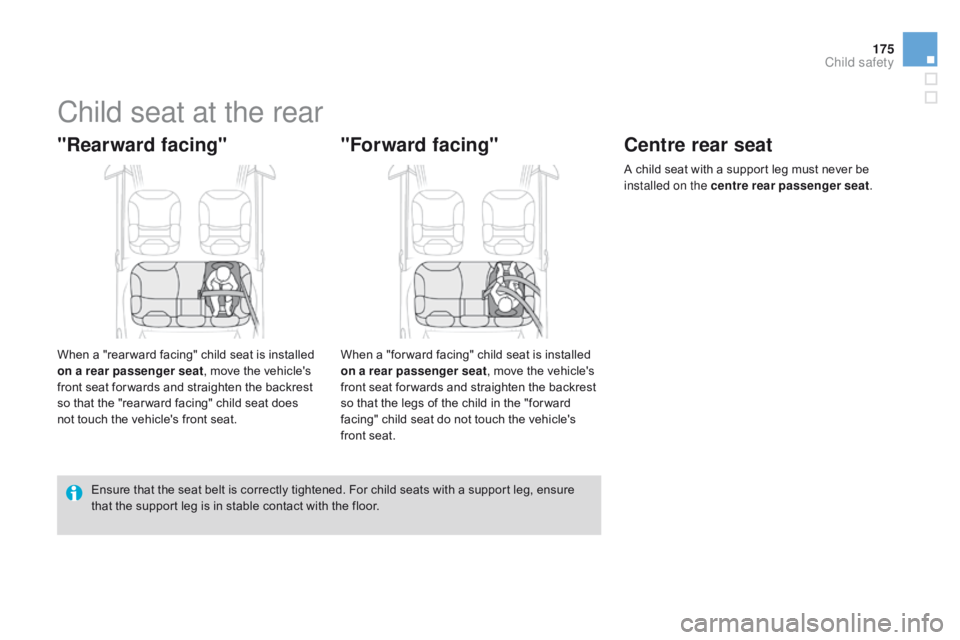
175
DS3_en_Chap09_securite-enfants_ed01-2014
Child seat at the rear
"Rearward facing"
When a "rear ward facing" child seat is installed on a rear passenger seat ,
move the vehicle's
f
ront seat for wards and straighten the backrest
s
o that the "rear ward facing" child seat does
n
ot touch the vehicle's front seat.
"Forward facing"
When a "for ward facing" child seat is installed on a rear passenger seat ,
move the vehicle's
f
ront seat for wards and straighten the backrest
s
o that the legs of the child in the "for ward
f
acing" child seat do not touch the vehicle's
f
ront seat.
centre rear seat
A child seat with a support leg must never be installed on the centre rear passenger seat .
Ensure
that
the
seat
belt
is
correctly
tightened.
For
child
seats
with
a
support
leg,
ensure
t
hat
the
support
leg
is
in
stable
contact
with
the
floor.
child safety
Page 178 of 404
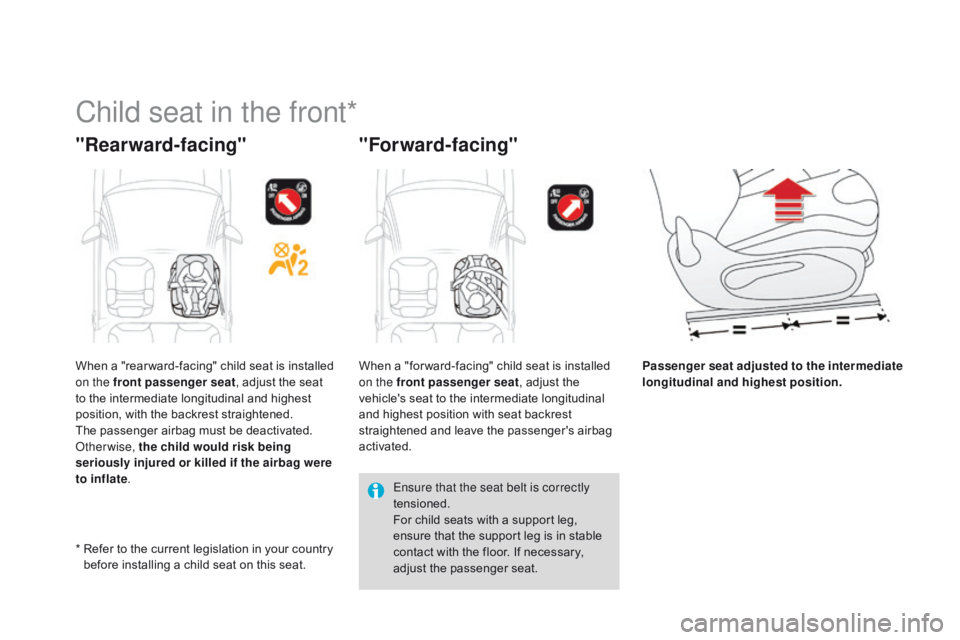
DS3_en_Chap09_securite-enfants_ed01-2014
Child seat in the front*
"Rearward-facing""For ward-facing"
Passenger seat adjusted to the intermediate
longitudinal and highest position.
*
R
efer
to
the
current
legislation
in
your
country
b
efore
installing
a
child
seat
on
this
seat.
When
a
"rear ward-facing"
child
seat
is
installed
o
n the front passenger seat ,
adjust
the
seat
t
o
the
intermediate
longitudinal
and
highest
p
osition,
with
the
backrest
straightened.
The
passenger
airbag
must
be
deactivated.
o
t
herwise, the child would risk being
seriously injured or killed if the airbag were
to inflate . When
a
"for ward-facing"
child
seat
is
installed
o
n the front passenger seat ,
adjust
the
v
ehicle's
seat
to
the
intermediate
longitudinal
a
nd
highest
position
with
seat
backrest
s
traightened
and
leave
the
passenger's
airbag
a
ctivated. Ensure that the seat belt is correctly
tensioned.
For
child
seats
with
a
support
leg,
e
nsure
that
the
support
leg
is
in
stable
c
ontact
with
the
floor.
If
necessary,
a
djust
t
he
p
assenger
sea
t.
Page 182 of 404

DS3_en_Chap09_securite-enfants_ed01-2014
Child seats recommended by CITROËNCITROËN offers a range of recommended child seats which are secured using a three point seat belt.
G roup 0+: from bir th to 13 kgL1
"RÖMER
b
a
by-Safe Plus"
Installed
in the rear ward facing position.
Groups 2 and 3: from 15 to 36 kg L4
"KLIPPAN
Optima"
From
22 kg (approximately 6 years), the booster is used on its own.
L5
"RÖMER
k IDFIX"
Can
be fitted to the vehicle's ISOFIX mountings.
The
child is restrained by the seat belt.
Page 183 of 404
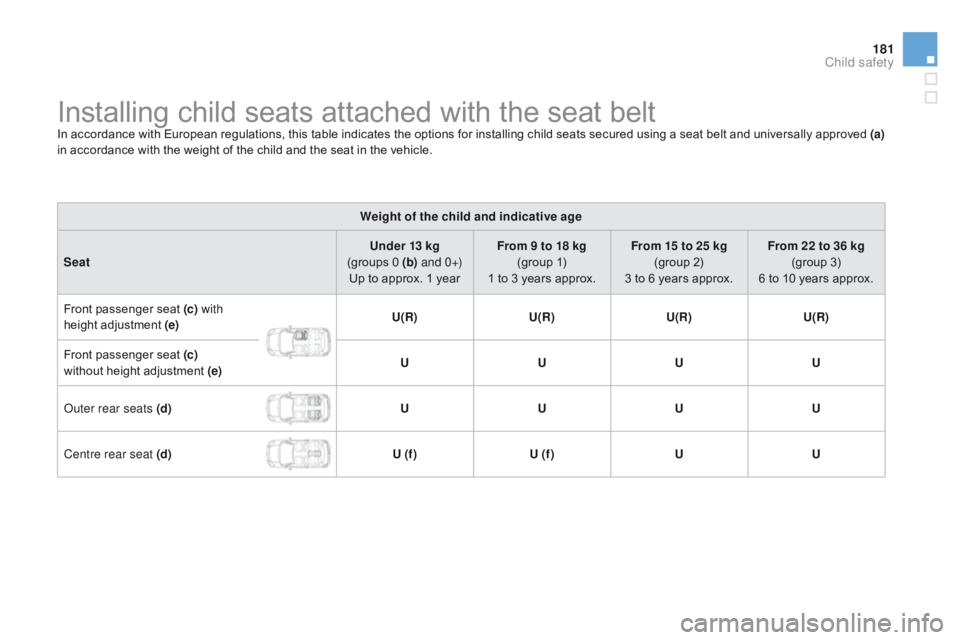
181
DS3_en_Chap09_securite-enfants_ed01-2014
Installing child seats attached with the seat beltIn accordance w ith European regulations, t his t able i ndicates t he o ptions for i nstalling c hild s eats s ecured using a seat b elt and u niversally approved (a)
in accordance with the weight of the child and the seat in the vehicle.
Weight of the child and indicative age
Seat Under 13 kg
(groups
0 (b) a n d 0 +)
Up
to approx. 1 yearFrom 9 to 18 kg
(group
1)
1
to 3 years approx.From 15 to 25 kg
(group
2)
3
to 6 years approx.From 22 to 36 kg
(group
3)
6
to 10 years approx.
Front
p
assenger
sea
t
(c)
with
height
adjustment (e) U(R)
U(R)U(R)U(R)
Front
p
assenger
sea
t
(c)
without
height adjustment (e) U
UUU
ou
ter rear seats (d) UUUU
Centre rear seat (d) U (f )U (f ) UU
child safety
Page 184 of 404

DS3_en_Chap09_securite-enfants_ed01-2014
(a) Universal child seat: child seat that can be i
nstalled in all vehicles using a seat belt.
(b )
G
roup 0: from birth to 10 kg. Shells seats
a
nd baby carriers cannot be installed in the
front
p
assenger
sea
t.
(c )
C
onsult the legislation in force in your
c
ountry before installing your child on this
sea
t.
(d)
T
o install a child seat on a rear seat,
rear ward
or for ward facing, move the front
s
eat for ward, then straighten the backrest
t
o allow enough room for the child seat and
t
he child's legs.
(e)
W
hen a rear ward facing child seat is
i
nstalled on the front passenger seat,
t
he passenger's front airbag must be
d
eactivated. Other wise the child would risk
b
eing seriously damaged or killed during
d
eployment of the airbag. When a for ward
f
acing child seat is installed on the front
p
assenger
sea
t,
t
he
p
assenger's
f
ront
a
irbag must remain active.
(f )
A
child seat with support leg must never be
i
nstalled
o
n
t
he
c
entre
r
ear
p
assenger
sea
t. Remove
and stow the head restraint
b
efore installing a child seat with a
b
ackrest on a passenger seat. Refit the
h
ead restraint once the child seat has
been
removed.
U: Seat suitable for the installation of a
child seat secured using a seat belt and
u
niversally approved, "rear ward-facing"
an
d/or
"
forward-facing".
U(R):
a
s for U,
with the passenger seat
a
djusted to its highest position and in the
in
termediate
l
ongitudinal
p
osition.